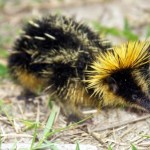madagascar
A collared brown lemur (Eulemur collaris) baby, photographed at the Bronx Zoo.
"Dinah", a young female gorilla kept at the Bronx Zoo in 1914. From the Zoological Society Bulletin.
Frustrated by the failure of gorillas to thrive in captivity, in 1914 the Bronx Zoo's director William Hornaday lamented "There is not the slightest reason to hope that an adult gorilla, either male or female, ever will be seen living in a zoological park or garden." Whereas wild adult gorillas were "savage" and "implacable" beasts which could not be captured (a photo of a sculpture included in Hornaday's article depicts a gorilla strangling one man, brandishing another about with its other…
A Madagascar sucker-footed bat (Myzopoda aurita).
In the tropical forests of Madagascar, there lives a very peculiar kind of bat. While most bats roost by hanging upside-down from cave ceilings or tree branches, the Madagascar sucker-footed bat (Myzopoda aurita) holds itself head-up thanks to a set of adhesive pads on its wings. Nor is it the only bat to do so. Thousands of miles away in the jungles of Central and South America, Spix's disk-winged bat (Thyroptera tricolor) does the same thing, but how do their sucker pads work, and why do they choose to roost in a different way from all…
A grey mouse lemur (Microcebus murinus). Image from Wikipedia.
Charles Darwin's visit to the Galapagos Archipelago has been celebrated time and again for its influence on his evolutionary thoughts, but I have to wonder what would have happened if the Beagle skipped the Galapagos and visited Madagascar instead. What would Darwin have made of the animals which had been evolving in splendid isolation on the African island? Would "Darwin's lemurs", rather than Darwin's finches, be among the most recognizable icons of evolution?
Answers to such questions are beyond our grasp, but the diverse…
tags: reptiles, chameleon species, herpetology, Chris Raxworthy, research, American Museum of Natural History, AMNH, New York City, field research, nature, travel, Madagascar, speciation, streaming video
With Madagascar containing nearly two-third's of the world's chameleon species, Christopher Raxworthy, Associate Curator of Herpetology at the American Museum of Natural History, recently embarked on an expedition to the island in search of these special lizards. His hope was to track down the lined-chameleon in order to further study speciation on Madagascar.
Having recently returned from…
A ring-tailed lemur (Lemur catta), photographed at the Bronx Zoo.
Who doesn't love lemurs? The strepsirrhine primates, or wet-nosed cousins of ours, are favorite documentary subjects and extremely popular zoo attractions. And, in one of those bits of zoological trivia that everyone knows, lemurs only live on the island of Madagascar off Africa's southeastern coast. The question is how they got there.
Documenting the paths of animals during geological history is not an easy task. In the days before scientists understood plate tectonics, land bridges, now sunk beneath the ocean, were often…
While we usually bring you hard-hitting, fact-based (like pleather is leather-based) news, sometimes we stumble across something that is simply news to us. In this case, it's the existence of what appears to be a cross between a colorful sea slug and a shrew called a Lowland Streaked Tenrec (Hemicentetes semispinosus).
Since these pictures in and of themselves aren't much of a post, please gather round the campfire for a bit more info on tenrecs. As any self-respecting pretend biologist can tell you, tenrecs are a distinct family of mammals that spent the last few million years evolving…
Aptinoma antongil Fisher 2009
Brian Fisher has a paper out in Zootaxa this week describing a pair of new ant genera from Madagascar. Aptinoma and Ravavy are small ants in the subfamily dolichoderinae related to Tapinoma and Technomyrmex. Apparently, the backstory on these new ants is that ongoing genetic research from the Ant Tree of Life project revealed some Malagasy specimens to be rather distantly related to any of the previously described genera. On closer morphological inspection, Fisher found several differences that allow for the new genera to be reliably…
After reading my pitiable lament about the demise of several domestic artisan chocolate factories, my friend wunx sent me two bars of Amano chocolate! Yum! I don't know why it seems so odd to me that good dark chocolate is being made just outside Salt Lake City, but Amano's product is delicious. I highly recommend both the Madagascar and the Ocumare; the Madagascar is sharp with a tangy citrus note, while the Ocumare is smoother. I can tell you that both go wonderfully with a nice pinot noir.
Amano also has a rather nice chocolate blog - check out their historical look at a chocolate factory…
Researchers from Oklahoma State University have discovered the shortest living tetrapod (four limbed vertebrate) to date. The hard-livin' Labord's Chameleon spends 8-9 months incubating within the egg, only to hatch and die 4-5 months later. Published in the July issue of the Proceedings of the National Academy of Sciences, the report states: "Remarkably, this chameleon spends more of its short annual life cycle inside the egg than outside of it. Our review of tetrapod longevity (>1,700 species) finds no others with such a short life span." Most tetrapods live between 2 and 10 years.
8…
Odontomachus coquereli - Madagascar
Myrmecology continues to lead the way in online taxonomy. Today saw the release of the very first taxonomic paper published by the top-tier open access science journal, PLoS One.
Brian Fisher and Alex Smith combine alpha taxonomy with DNA barcoding to produce a revision of the Malagasy trap-jaw ants. The revision includes mitochondrial DNA sequences from some 500 individual ants and resulted in the inference of several new species. I've got plenty to say about DNA barcoding, but I'll leave that for a later post and instead point you to the thoughtful…
Scientists in Madagascar recently discovered the remains of a giant prehistoric frog, a relative of today's horned toads, which blew away the previous record for the largest known frog, Bennicus Bleimanicus. Dubbed Beelzebufo, meaning "frog from hell," the Devil Frog had important differences from today's frogs. To begin with, it was freakin huge. Susan Evans, a researcher from the University College of London, explained that if it was anything like its closest living forebears, "it would have been quite mean." Considering the fact that it was "the size of a slightly squashed beach-ball,…
Rejected by his parents at birth, Bilbo the bamboo lemur was raised by hand by zookeeper Veronica Lindberg. As a result, Bilbo thinks he is a human and refuses to leave Veronica's side. Clinging to her back, wrapped around her arm or perching on her head, the two are inseparable. Raising Bilbo is no easy task as he must be fed once an hour, every hour. His photogenic furriness has made him a media darling in Sweden, although the country's hopes of dethroning Germany's nauseatingly adorable polar bear cub, Knut, are misplaced.
Bilbo shows-off "Blue Steel". Bamboo Lemur, genus Hapalemur
We…
Late last year, scientists discovered a new species of bat that has large flat adhesive suckers attached to its thumbs and hind feet. These suckers allow the bat to climb and adhere to large broad-leaf plants in the jungles of their native Madagascar.
The find is particularly remarkable because the new bat belongs to a Family of bats, Myzopoda, that was previously considered to include a single rare species. In a rare success story, these endangered bats are thriving in recently cleared forests where the pioneering Traveler's Palm often replaces native vegetation after logging. The plant has…

